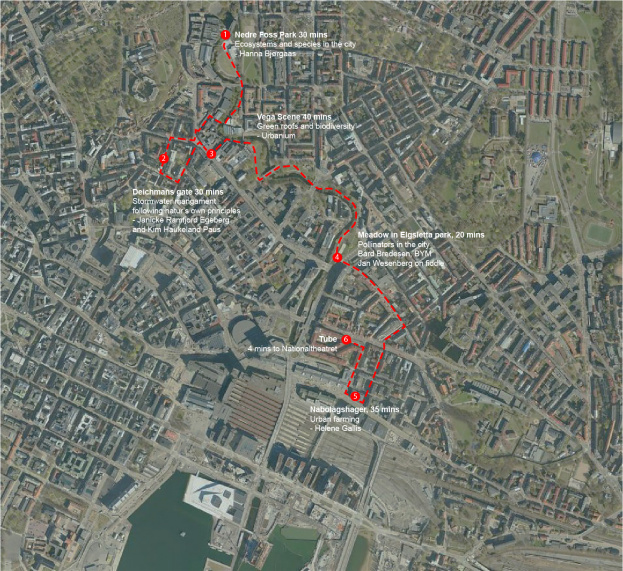Walks+Talks: Urban Ecology
Urban ecology in inner city
In the face of climate change, urbanization and loss of biodiversity, urban ecology plays a key role in maintaining our health, safety and wellbeing. This city tour takes you to pilot projects where restoring habitats as well as enhancing the relationship between people and nature are at focus. We are going to take a closer look at green roofs that are designed specifically to accommodate native species, projects following nature’s own principles for stormwater treatment, and communities for farming, beekeeping and harvesting in the city.
1: Nedre Foss
Species and habitats in the city
Looking at how Oslo is placed geographically, facing south, close to water, well protected and with a friendly climate, it’s easy to understand that people settled here thousands of years ago. It’s also easy to understand that the area must have been a unique hot spot for biodiversity. More surprisingly perhaps, the modern Oslo still holds a rich wildlife. Careful planning will contribute to maintain as much of possible of the “green city”, and that will be of great value not only for nature itself, but also for the well-being of its inhabitants. What interesting species will turn up at our excursion?
2: Deichmans gate
Stormwater management following natur’s own principles
Deichmans gate and Wilses gate are streets located in the neighborhoods of Grünerløkka and St. Hanshaugen in central Oslo. They are home to Norways first integrated local stormwater management facility found in an urban setting. With denser cities, more extreme weather and worsening sewers systems, there is a need to manage rainwater at surface level rather than in the piped sub-surface system. Positively, surface based stormwater management systems with vegetation provide additional values beyond water retention. An approach where rainwater is considered a resource and not a problem is vital, but which also demands the need for interdisciplinary planning. In this context landscape architecture is a key profession in developing climate-adapted, robust and attractive cities. This is a project where science truly meets art.
3: Vega scene
Green roof
Vega Scene is a newly opened art cinema- and theater building based in a rough, urban neighborhood in the center of Oslo. It displays a first-in-class ballasted green roof, covered by custom lightweight soil mix and vegetation native to the Oslo region. Seeds were collected in the Oslo area and have been cultivated at a domestic plant nursery. Only a few weeks after plugging hundreds of small perennials in the limestone-rich soil, the roof is lush, green and flowery, and frequently visited by wild bees and hops. The membrane and lava stone ballast has the capacity of holding back rainwater equivalent to a 20-year flood, mitigating the need for separate outfall basins and reducing pressure on the heavily overloaded drainage system in Oslo. The building is being BREEAM certified.
4: Elgsletta park
Meadows and pollinators in the city
Development and unfortunate management have resulted in loss of many important nature areas over the years in Oslo. This is especially true of the meadows and the many pollinators that live here. The Agency for Urban Environment have therefore in recent years worked quite systematically to get the meadows and pollinators back, by managing and establishing a network of meadows. The meadows are established in different ways, and in some places we have restored meadows that have deteriorated. At Elgsletta we have chosen to establish a species-poor meadow with red clover (Trifolium pratense). Red clover is a valuable nutritional plant for many insects, including several redlisted insect-species found in the city. Picture texts: Meadow with red clover (Trifolium pratense) and ox-eye daisy (Leucanthemum vulgare) along the harbor of Oslo. Foto: Bård Bredesen Kløverhumle (Bombus distinguendus), which is threatened, on red clover (Trifolium pratense). Foto: Bård Bredesen
5: Nabolagshager, Greenhouse
Urban farming
Nabolagshager is based at Grønland which has been a hot spot for food production and distribution since the Viking age. We will hear about rooftop garden’s potential for creating green and social meeting places in the dense city, potential for social entrepreneurship and some of Nabolagshager’s programs for more vulnerable groups in our society. What role could urban farming play in modern urban development? How many tons of ecological strawberries could we grow at the flat rooftops of Oslo? And is food grown in the city really safe to eat?
IFLA World Congress 2019 will take a closer look at urban transformation, green mobility, healthy and beautiful landscapes and community participation. During three days in Oslo, we aim to inspire, challenge and intrigue you. We want you to share and reflect on the knowledge that is developed, presented and discussed.
Join us in moving one step further to understand and protect our COMMON GROUND.
This article is part of IFLA Common Grounds: Walk+Talk.
You can view all Walks+Talks tours here


